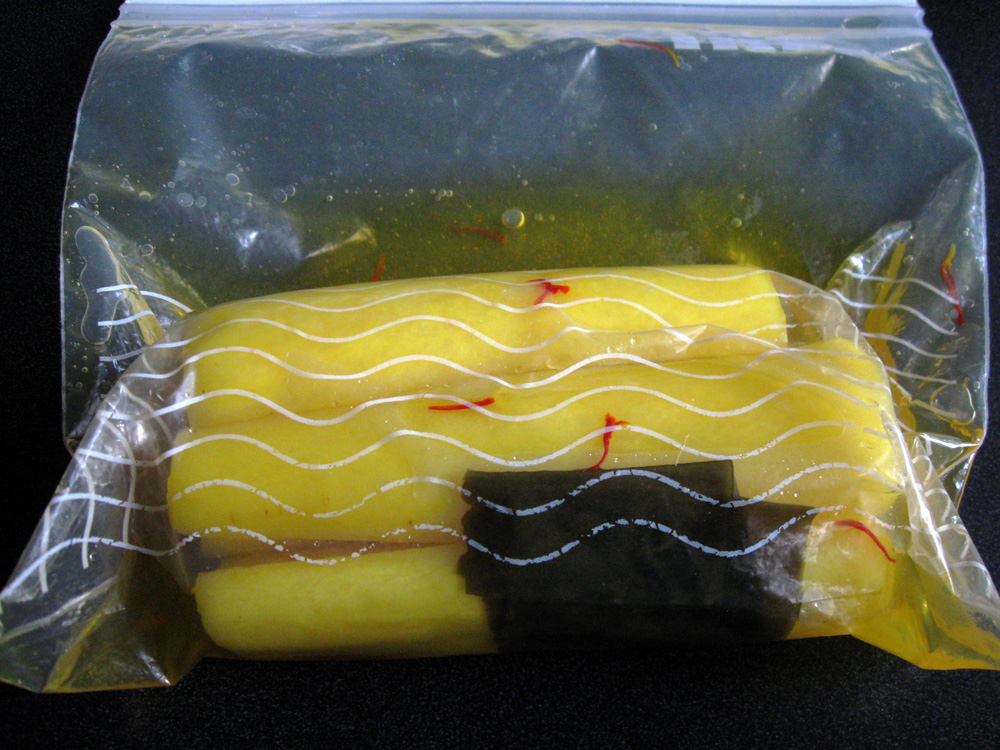
Japanese pickled Daikon is called ‘Takuan’. My mother used to pickle Daikon in a huge bucket-like container every year. She would hang Daikon in the sun for a few weeks until dehydrated and wilted, then pickle them with a mixture of Salt, Rice Bran, Kombu (Kelp), and some Citrus Peels. She probably added ‘Kuchinashi’ (Cape Jasmine) Seeds for yellow colouring. I don’t think she added Sugar because her ‘Takuan’ were not sweet at all. I prefer slightly sweet ones.
Store-bought ‘Takuan’ is made with artificial colour, sweeteners and preservatives. When I want to eat ‘Takuan’, I make a small batch. This is my easy method, and I use a ziplock bag that can be used repeatedly.
Ingredients
1 medium Daikon *about 500g after peeled
2 tablespoon Water
1 pinch Saffron Threads *OR 1 teaspoon Ground Turmeric if you don’t mind its smell
1 tablespoon Salt *3% weight of Daikon
3-4 tablespoons Sugar *10% weight of Daikon
2 tablespoons Rice Vinegar *5% weight of Daikon
5cm Kombu (Kelp)
Method
- Peel Daikon and cut into the length that fits into the bag. Cut in half lengthways if thick. Place them on a tray lined with a tea towel and leave them under the sun for 2-3 days or until wilted.
- Combine Water and Saffron Threads in a small bowl and set aside until the Water turned yellow. *Note: Ground Turmeric can be used, but colouring is optional.
- Place everything in a ziplock bag, rub and combine well, then remove the air. Leave the bag in the fridge for at least 7 days. Change the position occasionally.

- *Note: Pickled Vegetables are salty as the salt is necessary to preserve them. If you concern the amount of salt in ‘Takuan’, soak the sliced ‘Takuan’ in enough water with some Sugar and Vinegar before you eat, so that you can reduce the salt.

Comments
Tas
20/08/2025
I also live in Melbourne and made these pickles. It was great to have a recipe that used ingredients I could find and the pickles are SO DELICIOUS! This will definitely become a staple in my household. Thank you so much!
Hiroko
20/08/2025
Hi Tas. We are lucky in Melbourne, aren’t we? We can get so many different foods, spices, sauces, and more. I’m glad to know you like this pickled daikon recipe. No artificial ingredient and chemical is a good part of it.
TT-chun
24/04/2025
Howdy from Texas Hiroko!! Do you have a TikTok page?? I tried searching for you with no luck. Arigato for this!! I am going to try this recipe on my next grocery run. I am looking forward to your website. I stumbled across here looking up saccharin as I always get Takun from the store but remembered hearing it was a cancer-causer growing up. Then that led to curiosity of how to make it from scratch and here I am!!
Hiroko
24/04/2025
Hello from Melbourne, Australia. Thank you for your comment. I don’t do TikTok. I don’t do YouTube either. My brain is getting old and I can’t keep up those things. By the way, I have the concern about preservatives and artificial colour of commercially produced pickled Daikon. It is very simple to make at home. You don’t need to colour it if you prefer. Enjoy making it.
Martin
13/06/2025
Hi, how essential would you rate the Kombu to the final flavour? You’re the only recipe I’ve seen that uses it. Also won’t the “sliminess” of cooked Kombu also leach out during the long fermentation period?
Hiroko
14/06/2025
Hi Martin. Thank you for asking me a question. Kombu is not essential, but I add it for any quick pickles as Kombu adds Umami, which can’t be achieved when vegetables are pickled only for a few days or shorter. It won’t get slimy, and the pickled Kombu can be eaten if it is soft enough. If you are planning to ferment Daikon by pickling for a long period of time, you definitely don’t need to add it.